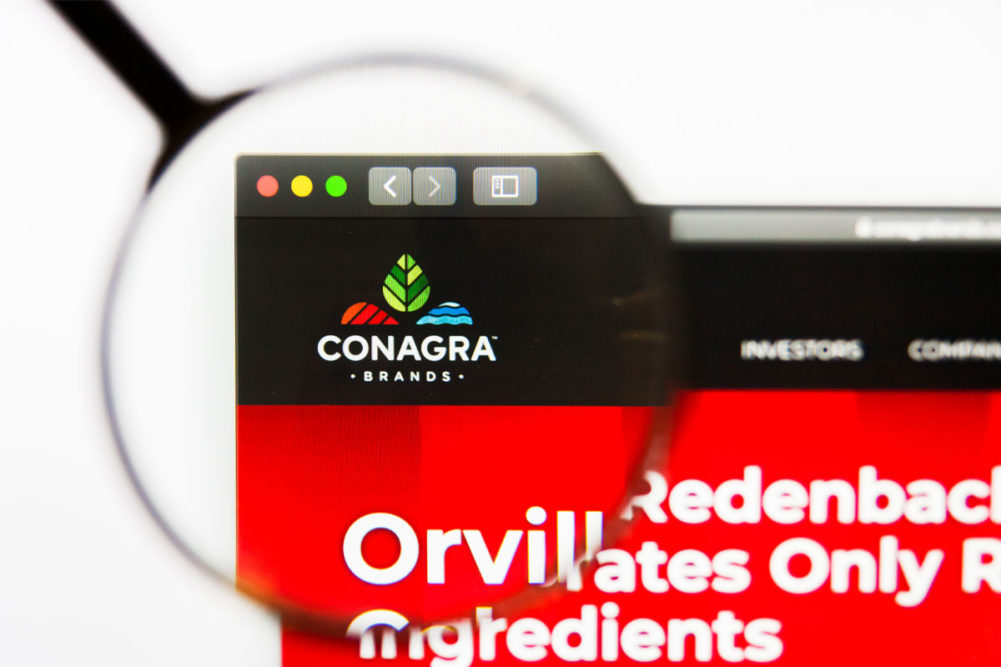CHICAGO — Several unexpected issues affected Conagra Brands, Inc.’s first-quarter results. The issues masked what otherwise was a positive quarter for the company.
During the quarter, the company reorganized its reporting structure for certain brands within its Refrigerated and Frozen business unit. As part of the changes the company recorded a $386 million goodwill and brand impairment charge with $244 million associated with its Bird’s Eye business.
Adding to the pressure were supply chain disruptions in the Foodservice and canned chili businesses.
“In our Foodservice business, we identified an off-spec finished good issue while producing product for a customer,” said Sean M. Connolly, president and chief executive officer, during an Oct. 6 call to discuss first-quarter results. “We disposed of the product and lost manufacturing time during our diagnostic. This pulled sales and gross margin below where they should have been.”
The company also identified canned chili product that was off spec, had to be disposed of and led to lost inventory.
“While production is now back up and running properly, the lost inventory effect will linger into Q2, impacting volumes and margins,” Mr. Connolly said. “The point is, these types of challenges can result in downtime needed to determine and solve the root cause of the issue as well as proper testing to ramp production back up. That lost time can result in higher costs and less production.”
Mr. Connolly added that there is clear progress in Conagra’s supply chain as well as in the supply chains of the company’s peers, with service levels improving and productivity tracking well. But they are “not flawless” and will remain “dynamic” for the foreseeable future
For the quarter ended Aug. 28, Conagra Brands recorded a loss of $78 million, down significantly from the year before when the company earned $235 million, equal to 49¢ per share on the common stock.
Quarterly sales rose to $2.9 billion from $2.7 billion the year prior.
“We continued to gain market share at the total portfolio level, particularly within our strategic frozen and snacks domains, and drove solid profit improvement during the quarter,” Mr. Connolly said. “We also saw another strong performance from Ardent Mills as effective management enabled the joint venture to continue capitalizing on volatility in the wheat markets.”
Conagra’s adjusted net income increased 14% to $275 million, or 57¢ per share, according to the company. The increase was driven primarily by an increase in gross profit and the performance from the company's Ardent Mills joint venture.
The company raised prices in fiscal 2022 and continued to do so during the first quarter.
“As you would expect, pricing has driven some volume elasticities both for Conagra and the overall industry,” Mr. Connolly said. “This tends to be most acute in the immediate aftermath of new pricing and wanes over time as consumers adjust.”
He added that Conagra’s net elasticities have remained “nearly flat” over the past few quarters.
“What you should expect in a super cycle of pricing like we've seen right now is that there will be modest short-term impacts on household penetration as consumers defer purchases,” Mr. Connolly said. “And that's kind of — you see it really show up in the shopping data when people — their big trips become smaller trips, and they postpone purchases, and their buying rate will drop a bit.”
Conagra Brands plans to continue raising prices in the second and third quarters.
“We continue to expect the inflationary environment to persist, but moderate through calendar year '23, which will result in a low teens inflation rate for our fiscal year '23 weighted toward the first half of the fiscal year,” said David S. Marberger, chief financial officer. “We also expect previously communicated pricing actions in light of these costs to become effective early in the second quarter, likely causing volume to decline.
“We recently communicated some additional pricing that will be effective in Q3. However, the magnitude will be smaller and more targeted than previous pricing actions. As always, we will continue to monitor inflation levels and price as needed to manage future volatility.”
The company reaffirmed its fiscal 2023 guidance of organic net sales growth between 4% to 5% and adjusted EPS growth of 1% to 5% over fiscal 2022. But management is expecting continued supply chain inefficiencies and incremental volume weakness as prices are raised. It was also noted that despite the strong performance of the Ardent Mills joint venture during the quarter, the elevated level is not expected to continue throughout the remainder of the fiscal year.





